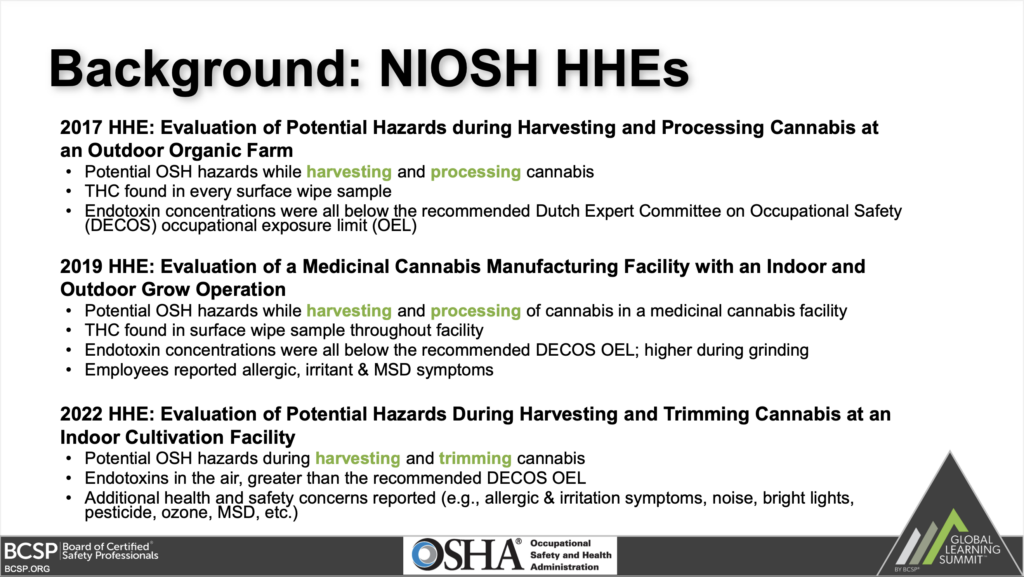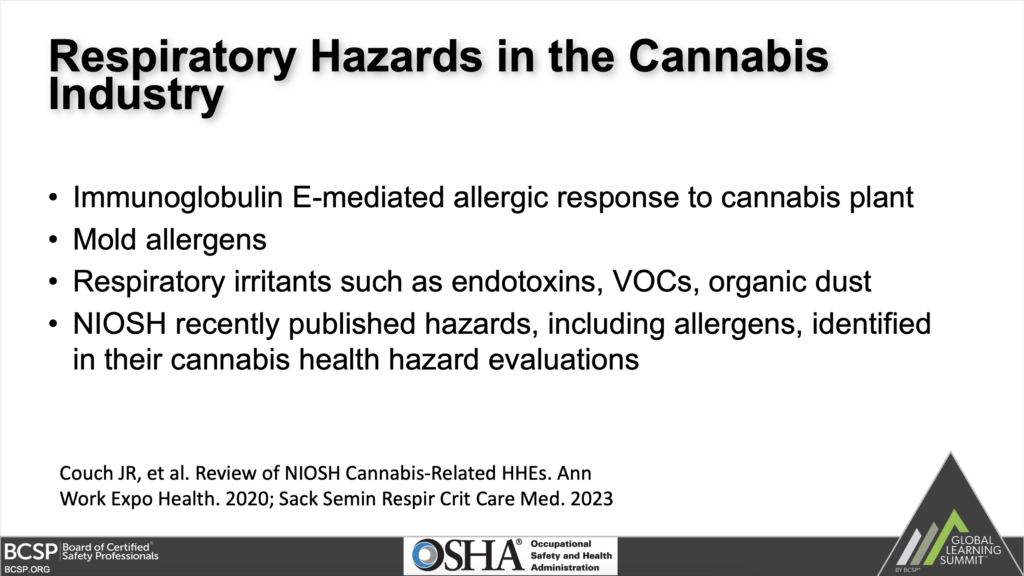Politics
Federal OSHA Officials Discuss Marijuana Industry Worker Safety

Two officials with the federal Occupational Safety and Health Administration (OSHA) spoke this week about the agency’s latest guidance and priorities for “protecting workers within the cannabis industry” in the growing number of state-legal markets.
One official called for better tracking and reporting of negative health outcomes after recounting what she described as “the first fatality from occupational asthma in the U.S. cannabis industry”—a Massachusetts worker for the multi-state operator Trulieve who collapsed at work and died in 2022.
The Tuesday webinar featured two OSHA representatives: Yasmine Daniels, an industrial hygienist with the agency, and Virginia Weaver, a doctor and medical officer. Daniels began by giving an overview of OSHA’s federal and state guidelines and how those apply to cannabis, while Weaver spoke to the 2022 asthma death and how to better prevent such incidents.
“The most important thing is involvement from the industry to train workers and managers to identify and report symptoms of occupational allergy,” Weaver said at the online event hosted by the Board of Certified Safety Professionals, an organization that certifies safety practitioners. “Workers who develop a runny nose, rhinitis, congestion, eye or throat irritation, skin rash or hives—or, even more importantly, if it’s already progressed to lung symptoms, with cough, wheezing or shortness of breath—they need to know who to report that to in their workplace as soon as these develop.”
Though cannabis is still illegal under federal law, OSHA’s federal or state plans around health and safety standards are nevertheless “applicable to employers engaged in commercial cannabis,” Daniels’s presentation said. That comes not only through federal guidance but also OSHA-approved state plans in 29 jurisdictions, most of which apply to both public and private employees.
Some state plans, such as those in Michigan, Oregon and Washington State, include specific guidance and enforcement details around commercial cannabis operations. For example, the Michigan Occupational Safety and Health Administration (MIOSHA) recently issued a state emphasis program “that covers the growing, harvesting and processing of the plant,” Daniels said. “They also provide guidance, working together with the state’s Cannabis Regulatory Agency.”
State guidance on employment conditions can also come from other agencies, such as public health departments, she noted. “So just because there is an OSHA-approved state plan does not necessarily mean that the plan would be responsible for regulations and guidance over this industry.”
Among the duties employers have, Daniels said in the Q&A section of the webinar, is to label containers of hazardous chemicals. “It is in fact the employer’s responsibility to do a workplace hazard assessment to determine the employees’ potential of being exposed to that chemical hazard,” she said. “And if in fact there is, then the employer should have a hazard communication program in place.”
One way SAMHSA learns about health hazards to marijuana industry workers is through collaboration with the National Institute of Occupational Safety and Health (NIOSH), “which provides us with the latest on worker safety and health research,” Daniels explained.
For example, NIOSH evaluations in 2017, 2019 and 2022 flagged potential hazards in jobs harvesting, trimming and processing cannabis. The agency began providing recommendations for how to reduce those hazards and prevent work-related illnesses.

OSHA via BCSP
“A common theme across all of those HHEs, or health hazard evaluations, is that employees were often exposed to tetrahydrocannabinol—which we know as THC—that was present along surfaces throughout some of the facilities,” she said. “Employees were also found to be exposed to airborne concentrations of endotoxins, which…cause adverse respiratory effects such as chronic bronchitis and asthma.”
While OSHA hasn’t set a limit on endotoxins, Daniels said NIOSH consulted with authorities in the Netherlands, who set an exposure limit of 90 endotoxin units per cubic meter of air. Measured concentrations in American workplaces were found to exceed those limits, she said.
Within the industry broadly, risks to workers can vary considerably by what kind of business they work for, Daniels added. Growers might be more exposed to mold, pesticides and flammable liquids. Processors might deal with solvents, combustible dust and loud noise. And retail workers could see exposure to various chemicals as well as workplace violence.

OSHA via BCSP
Daniels said that while the cannabis industry has several unique considerations, guidance from other sectors—like the tobacco industry or even grain production—provides a useful reference for some of the issues facing marijuana employees.
Weaver’s portion of the presentation focused on the 2022 death of Massachusetts cannabis worker Lorna McMurrey, 27, who collapsed at a Trulieve cultivation facility. An OSHA investigation published the next year found her death was the result of occupational asthma that led to cardiac arrest and anoxic brain injury.
Weaver, who was the lead author on that investigation, said the “first major point” she wanted to make “is that the magnitude of exposures in the occupational setting is way, way more than the recreational setting.”
“There are some who think that because a number of cannabis employees may also use the product recreationally, they couldn’t possibly develop any work-related symptoms from it,” she said. “That’s in fact not the case. The exposures in the occupational setting are much greater.”

OSHA via BCSP
In Washington State, Weaver noted that a review of workers’ compensation claims from legal cannabis employees found 10 cases of marijuana-related occupational asthma, seven of which occurred at indoor marijuana production facilities. A 2020 questionnaire of Washington cannabis workers found that 22 of 31 respondents reported one or more work-related symptoms. Two thirds (65 percent) of those were respiratory issues, followed by eye, nasal and skin-related symptoms.
Weaver said better detection protocols at workplaces, referrals to appropriate specialists and robust research into cannabis-related risks are essential to improve health and safety in the industry.
“Importantly, we need research because we need to know which exposures and job titles are the highest risk for these respiratory outcomes,” she said. “Because you can’t prevent what you aren’t able to identify.”
Weaver added that it would also be helpful “to have diagnostic tests for cannabis sensitization so that we have a better way of diagnosing which symptomatic employees in fact have which responses” to irritants in the work environment.
Daniels concluded the event by noting that while legal issues around drug testing weren’t the focus of the presentation, OSHA recently issued a memo about drug testing policies, which she said is important “especially in the culture where marijuana and drug use by employees could become a concern by the employer.”
“To summarize, federal law does not prevent employers from conducting pre-employment drug testing or testing based on reasonable suspicion, periodic or random drug testing, depending on the nature of the employment, as well as post-incident drug testing,” she said. “Any action taken under the post-incident drug-testing policy would only be a violation if the employer took that action to penalize the employee for reporting a work-related injury or illness rather than for the legitimate purpose of promoting workplace safety and health.”
An OSHA official said last year that the federal government’s ongoing prohibition of marijuana makes the agency’s job “complicated” when it comes to ensuring the safety of workers in the cannabis industry.
Andrew Levinson, director of OSHA’s Directorate of Standards and Guidance, said at a late-May meeting of the National Advisory Committee on Occupational Safety and Health (NACOSH) that “the cannabis industry is a little bit complicated for federal agencies because cannabis is still illegal at the federal level.”
“So there’s kind of state activity going on. We still go out and deal with those issues, but the policy issues there are complicated,” he said, adding at the time that he wasn’t sure if there had been workplace fatalities in the marijuana sector.
As for the Massachusetts cannabis worker who died after collapsing at a facility operated by the multistate operator Trulieve, the company paid OSHA $14,502 to settle the case, also agreeing to conduct a study to “determine whether ground cannabis dust is required to be classified as a ‘hazardous chemical’ in the occupational setting,” according to a press release at the time.
At last year’s NACOSH meeting Levinson acknowledged the Massachusetts death and said that “we still go out when OSHA would normally go out, but from a policy perspective, the way that we develop materials for specific industries is a little bit complicated by the legal issues.”
In June of last year, the leader of one of the country’s largest labor unions is called on President Joe Biden to end federal marijuana prohibition—and he also urged the administration to allow OSHA to “immediately start work on a national workplace safety standard for legal cannabis business, using the regulations set by California as a model.”
Congressional Lawmakers Approve GOP-Led Marijuana And Psychedelics Bills Focused On Veterans
Photo courtesy of Chris Wallis // Side Pocket Images.















